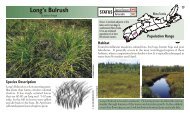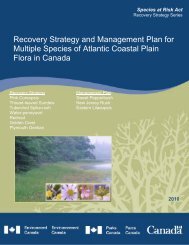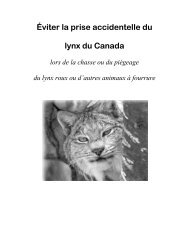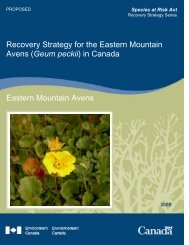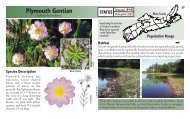Healthy Lakes and Wetlands For Tomorrow - Species at Risk
Healthy Lakes and Wetlands For Tomorrow - Species at Risk
Healthy Lakes and Wetlands For Tomorrow - Species at Risk
Create successful ePaper yourself
Turn your PDF publications into a flip-book with our unique Google optimized e-Paper software.
RECREATIONAL ACTIVITIES<br />
Humans are a part of the n<strong>at</strong>ural environment <strong>and</strong> swimming, hiking, biking, snowshoeing, skiing,<br />
canoeing, kayaking, <strong>and</strong> camping are all gre<strong>at</strong> ways to enjoy the outdoors. Try to leave the areas<br />
you visit in the same st<strong>at</strong>e as when you first arrived so th<strong>at</strong> you <strong>and</strong> others can enjoy these places<br />
in the future. Share the experiences you have <strong>and</strong> the Leave No Trace principles with your friends<br />
<strong>and</strong> family <strong>and</strong> encourage them to spend time outdoors as well.<br />
Keep it Wild!<br />
The seven Leave No Trace principles are gre<strong>at</strong> guidelines to follow when spending time in the<br />
woods:<br />
1. Plan Ahead <strong>and</strong> Prepare<br />
2. Travel <strong>and</strong> Camp on Durable Surfaces<br />
3. Dispose of Waste Properly<br />
4. Leave Wh<strong>at</strong> You Find<br />
5. Minimize Campfire Impacts<br />
6. Respect Wildlife<br />
7. Be Consider<strong>at</strong>e of Others<br />
<strong>For</strong> more details on each of these principles <strong>and</strong> to learn more about Leave No Trace Canada please<br />
visit www.leavenotrace.ca or call 1-877-238-9343.<br />
To request a copy of “Keep it Wild: A Guide for Low Impact Recre<strong>at</strong>ion in Nova Scotia’s Wilderness<br />
Areas” call the Nova Scotia Environment Protected Areas Branch: 902-424-2117.<br />
Children <strong>and</strong> N<strong>at</strong>ure<br />
Kids today are spending less time in n<strong>at</strong>ure <strong>and</strong> more time indoors. It is<br />
estim<strong>at</strong>ed th<strong>at</strong> children spend over 30 hours a month with electronics <strong>and</strong><br />
less than an hour in n<strong>at</strong>ure. Studies have found th<strong>at</strong> kids can readily<br />
identify hundreds of corpor<strong>at</strong>e logos but few things in their backyard.<br />
The author of “Last Child in the Woods”, Richard Louv describes this as<br />
“n<strong>at</strong>ure deficit disorder” <strong>and</strong> has found th<strong>at</strong> a lost connection with the<br />
outdoors can increase the chances of depression <strong>and</strong> obesity. Children are<br />
our future - a strong connection with n<strong>at</strong>ure as a child can result in support<br />
as an adult to preserve <strong>and</strong> protect our precious n<strong>at</strong>ural areas. Our world<br />
is changing fast, we must reconnect our children. To view some n<strong>at</strong>ure<br />
activities for kids <strong>and</strong> families visit:<br />
Adventure Earth Centre: www.earthed.ns.ca<br />
Richard Louv’s site: http://richardlouv.com/children-n<strong>at</strong>ure-resources<br />
S. E<strong>at</strong>on<br />
47




